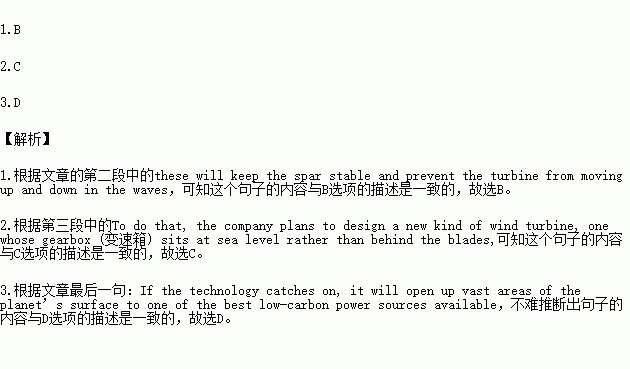题目内容
阅读下列短文,从每题所给的四个选项(A、B、C和D)中, 选出最佳选项。
According to the US government, wind farms off the Pacific coast could produce 900 gigawatts of electricity every year.Unfortunately, the water there is far too deep for even the tallest windmills to touch bottom.An experiment under way off the coast of Norway, however, could help put them anywhere.
The project, called Hywind, is the world’s first large-scale deepwater wind turbine (涡轮发电机).Although it uses a fairly standard 152-ton, 2.3-megawatt turbine, Hywind represents totally new technology.The turbine will be fixed 213 feet above the water on a floating spar, a technology Hywind’s creator, the Norwegian company StatoilHydro, has developed recently.The steel spar, which is filled with stones and goes 328 feet below the sea surface, will be tied to the ocean floor by three cables ; these will keep the spar stable and prevent the turbine from moving up and down in the waves.Hywind’s stability in the cold and rough sea would prove that even the deepest corners of the ocean are suitable for wind power.If all goes according to the plan, the turbine will start producing electricity six miles off the coast of southwestern Norway as early as September.
To produce electricity on a large scale, a commercial wind farm will have to use bigger turbines than Hywind does, but it’s difficult enough to balance such a large turbine so high on a floating spar in the middle of the ocean.To make that turbine heavier, the whole spar’s center of gravity must be moved much closer to the ocean’s surface.To do that, the company plans to design a new kind of wind turbine, one whose gearbox (变速箱) sits at sea level rather than behind the blades.
Hywind is a test run, but the benefits for perfecting floating wind-farm technology could be extremely large.Out at sea, the wind is often stronger and steadier than close to shore, where all existing offshore windmills are planted.Deep-sea farms are invisible from land, which helps overcome the windmill-as-eyesore objection.If the technology catches on, it will open up vast areas of the planet’s surface to one of the best low-carbon power sources available.
1.The Hywind project uses totally new technology to ensure the stability of_________.
A.the cables which tie the spar to the ocean floor
B.the spar which is floating in deep-sea water
C.the blades driven by strong and steady sea wind
D.the stones filled in the spar below the sea surface
2.To balance a bigger turbine high on a floating spar, a new type of turbine is to be designed with its gearbox sitting_________.
A.on the sea floor
B.on the spar top
C.at sea level
D.behind the blades
3.Wide applications of deepwater wind power technology can_________.
A.solve the technical problems of deepwater windmills
B.make financial profits by producing more turbines
C.settle the arguments about environmental problems
D.explore low-carbon power resources available at sea
Many people in the United States like eggs for breakfast. There are many different ways to cook eggs. One of the most common kinds of eggs for breakfast is scrambled eggs. In addition, this is one of the easiest dishes to cook. Read this recipe(秘法)for scrambled eggs and you will see how easy it is.
Scrambled Eggs | |
Utensils | Ingredients |
a frying pan a spatula(刮勺) 1 tea spoon a fork or spoon a small bowl | eggs 2 tablespoons of milk or butter salt pepper(胡椒) |
Steps:
1) Melt the butter in a frying pan over medium(适中的)heat.
2) In a small bowl, mix the eggs and the milk. Use the fork (or the spoon) to mix these well.
3) Pour this mixture into the pan.
4) Stir the eggs from time to time with the spatula. Continue until the eggs are no longer liquid.
5) Add salt and pepper. Add a little or a lot, as you like.
1.For this recipe, you do not need __________.
A. a knife B. a spatula C. a bowl D. a fork
2.Which of these steps comes first?
A. Stir the eggs with the spatula.
B. Eat the eggs for breakfast.
C. Add salt and pepper.
D. Mix the eggs and the milk.
3.Which of these words means “to change from solid to liquid”?
A. pour B. melt C. stir D. scramble

